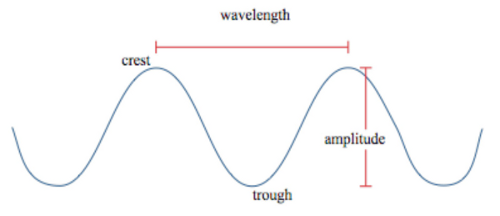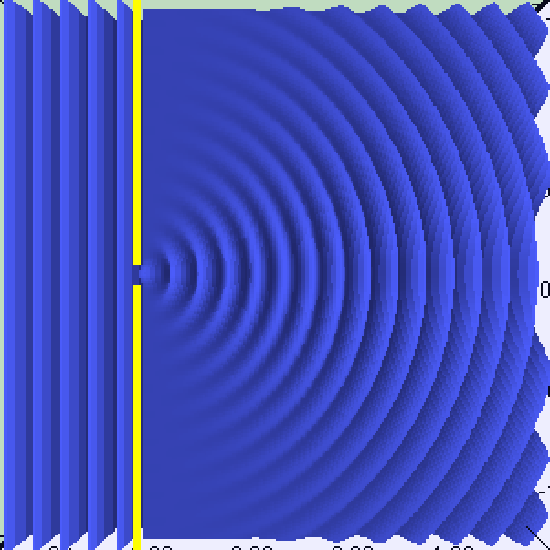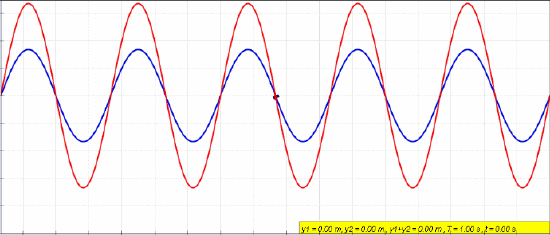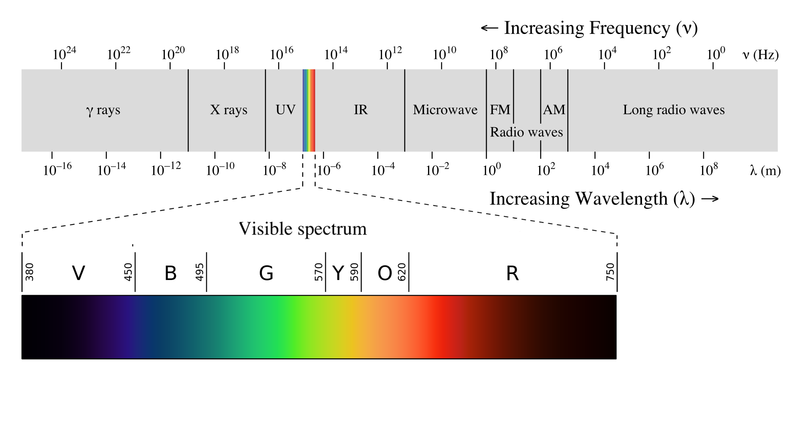4.1: Wave Properties
- Page ID
- 30872
4.1.1 Wave Properties
A wave is defined as the transmission of energy through a medium without the transport of matter. Picture waves in a pond as you through a rock into water. Ripples of water waves spread outward in concentric circles from the point of impact. The water itself is not traveling outwards. It is only moving up and down, but the energy from the impact travels through the water. Water waves are an example of transverse waves. In such a wave, motion of the medium is perpendicular to the direction of motion of the wave fronts. In contrast, sound waves are longitudinal waves, in which the medium compresses and expands in the same direction as the movement of the wave energy. Excessive wave consists of a series of crests, the point of highest displacement, and troughs, the points of lowest displacement. The amplitude of a wave is the maximum height of a crest. Waves are defined by their frequency, the number of wave crests that pass a point in a specific amount of time. The unit of frequency is generally given in cycles per second or Hertz. Waves also have a period, defined as the amount of time between successive crests. The relationship between frequency (f) and period (P) is given by the equation:
f = 1/P

 Waves can either be transverse or longitudinal
Waves can either be transverse or longitudinal
 A wave consists of an oscillating medium with maximums (crests) and minimums (troughs).
A wave consists of an oscillating medium with maximums (crests) and minimums (troughs).
Wavelength, the distance between two successive crests, is another important property in waves. Waves also travel a specific velocity and the relationship between velocity (v), frequency (f), and wavelength (λ) is given by the equation:
v = λf
We know that the speed of electromagnetic radiation is a constant, c = 3.0X108 m/s. This means that wavelength and frequency of electromagnetic radiation are inversely proportion to each other. The higher the frequency, the shorter the wavelength. The energy of electromagnetic radiation is also related to frequency by:
E = h × f = photon energy
Where h = 6.626 × 10-34 joule × s and is known as Planck’s Constant.
Waves have two additional properties that are important. The first is diffraction, or the bending of the wave front around a barrier. Again, we can use the analogy of water waters. As the wave hits a breakwater, part of the wave front is blocked, but part of it continues and propagates around the breakwater. The other key property is interference. Interference occurs when two or more waves interact with each other and they can interfere with each other destructively or constructively. Destructive interference happens when a crest and a trough coincide together, resulting in a dampening of the resulting wave’s amplitude. In contrast, constructive interference occurs when two crests or two troughs coincide with each other, producing higher crests or deeper troughs.
 Waves passing through a slit experience diffraction, in which the waves spread out in all directions.
Waves passing through a slit experience diffraction, in which the waves spread out in all directions.
 Two waves interacting will interfere with each other.
Two waves interacting will interfere with each other.
Studies of light have found that electromagnetic radiation has both properties of diffraction and interference, giving evidence its wave properties. But other studies have indicated that electromagnetic radiation also exists as discrete particles called photons. Every photo, however, has a specific wavelength and frequency associated with it and the energy of the photon is found by multiply its frequency by Planck’s constant.
4.1.2 Electromagnetic Waves
But if electromagnetic radiation is a wave, what it is traveling through? Water waves travel through wave and sound waves travel through the air and other mediums. Neither can travel through the vacuum of space because it lacks a physical medium. Scientists searched hard for a universal medium, which they called the Ether, through which electromagnetic waves travel. After repeated tests failed to find any evidence for the Ether, scientists had to conclude that it does not exist. Electromagnetic waves travel through nothing!
But what are they then?
Scientists had long known of the strong relationship between electric and magnetic fields. A charged particle placed in a magnetic field will accelerate along the magnetic field lines. Likewise, an electric field can induce a magnetic field in a conductor. Work by James Clerk Maxwell and other researchers soon found that an accelerated electric charge produces a fluctuation of both electric and magnetic fields. They determined that the electromagnetic wave is a combination of a fluctuating electric field and a fluctuating magnetic field, oscillating at right angles to each other and travel in a direction perpendicular to both.
As noted above, visible light is just a small portion of the entire electromagnetic spectrum. What we perceive as different colors is determined by different frequencies of light. Red has the lowest frequency and the longest wavelength while violet has the highest frequency and the shortest wavelength. A photo of violet light, therefore, has more energy than a photon of red light. Infrared radiation consists of wavelengths longer than red. Even longer wavelengths make up microwave and radio waves, which are used to cook food and for various communication systems, respectively. Ultraviolet rays have a higher frequency than violet light and Gamma and X-rays have even higher frequencies.
 An electromagnetic wave consists of an oscillating electric fields (E) and magnetic fields (B).
An electromagnetic wave consists of an oscillating electric fields (E) and magnetic fields (B).
It is not a coincidence that our eyes are sensitive to the frequencies that make up the visible portion of the spectrum. These are the frequencies of light that the Earth’s atmosphere is most transparent to. There are also other frequencies that can pass through the atmosphere, such as the near-infrared and parts of the radio spectrum with frequencies higher than the AM radio band. The Earth’s atmosphere blocks out most other forms of infrared radiation, as well as the high frequency ultraviolet, gamma, and X-ray ranges. This is good, as photons in these upper frequencies are the most damaging to our cells and can induce various from of cancer, including skin cancer.
 The Electromagnetic Spectrum.
The Electromagnetic Spectrum.

